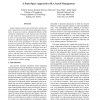17 search results - page 1 / 4 » SLA Decomposition: Translating Service Level Objectives to S... |
ICAC
2007
IEEE
13 years 11 months ago
2007
IEEE
In today’s complex and highly dynamic computing environments, systems/services have to be constantly adjusted to meet Service Level Agreements (SLAs) and to improve resource uti...
CLUSTER
2008
IEEE
13 years 4 months ago
2008
IEEE
Service providers and their customers agree on certain quality of service guarantees through Service Level Agreements (SLA). An SLA contains one or more Service Level Objectives (S...
NOMS
2008
IEEE
13 years 11 months ago
2008
IEEE
Large complex systems (such as Enterprise systems) are often composed of several interacting, independent components. In many such systems, although the behavior of the constituen...
ESOP
2007
Springer
13 years 10 months ago
2007
Springer
Abstract. Service Level Agreements are a key issue in Service Oriented Computing. SLA contracts specify client requirements and service guarantees, with emphasis on Quality of Serv...
HICSS
2008
IEEE
13 years 11 months ago
2008
IEEE
To distribute risk in Grid, the design of service level agreements (SLAs) plays an important role, since these contracts determine the price for a service at an agreed quality lev...

